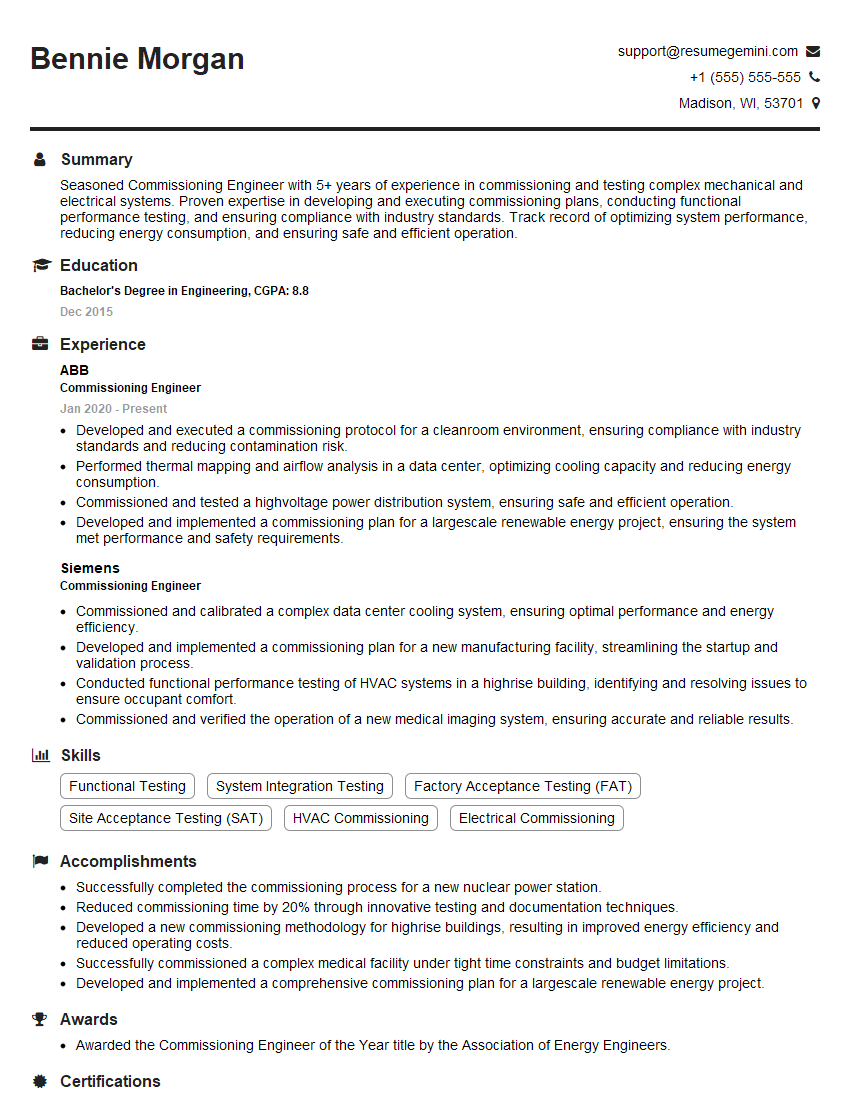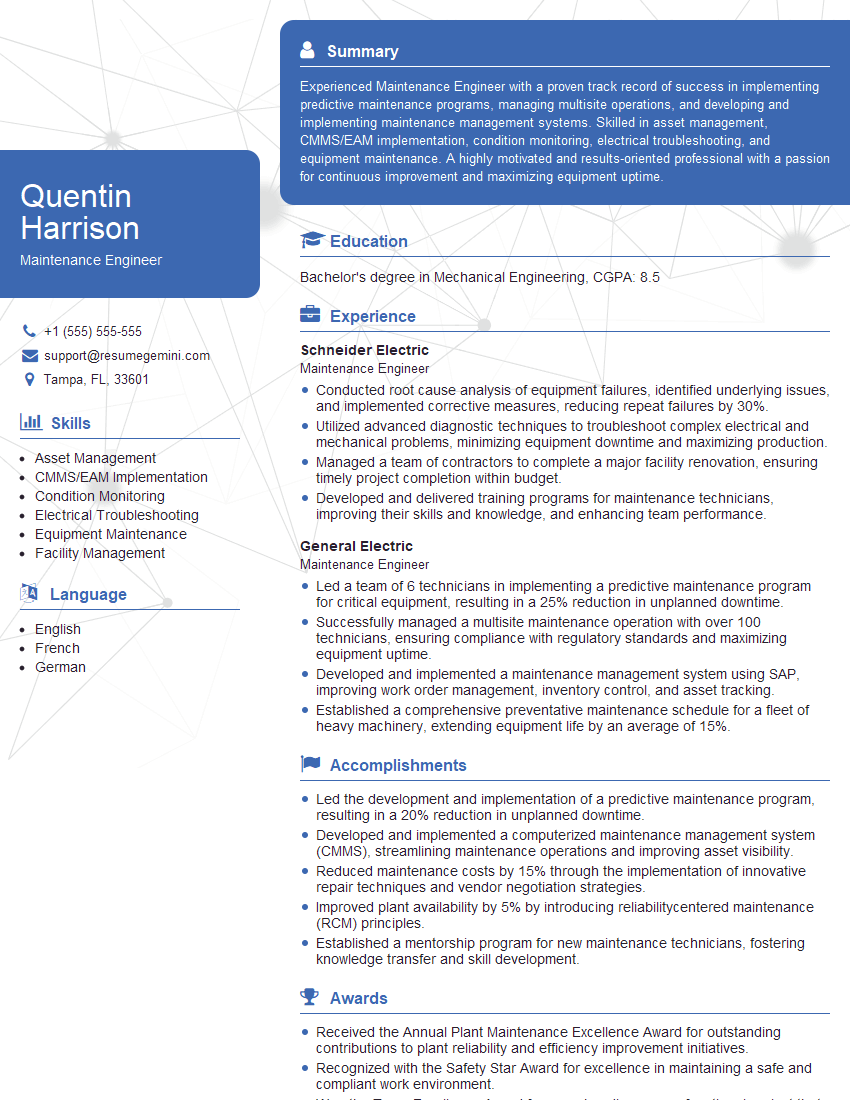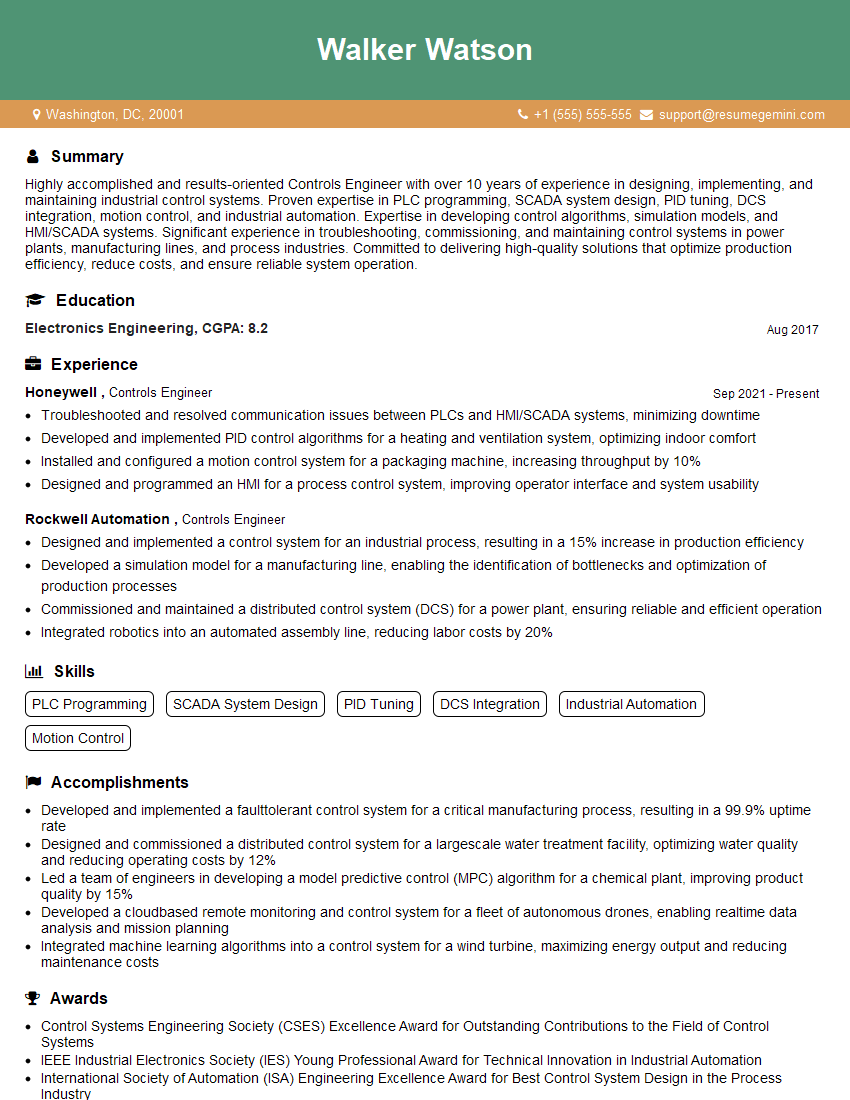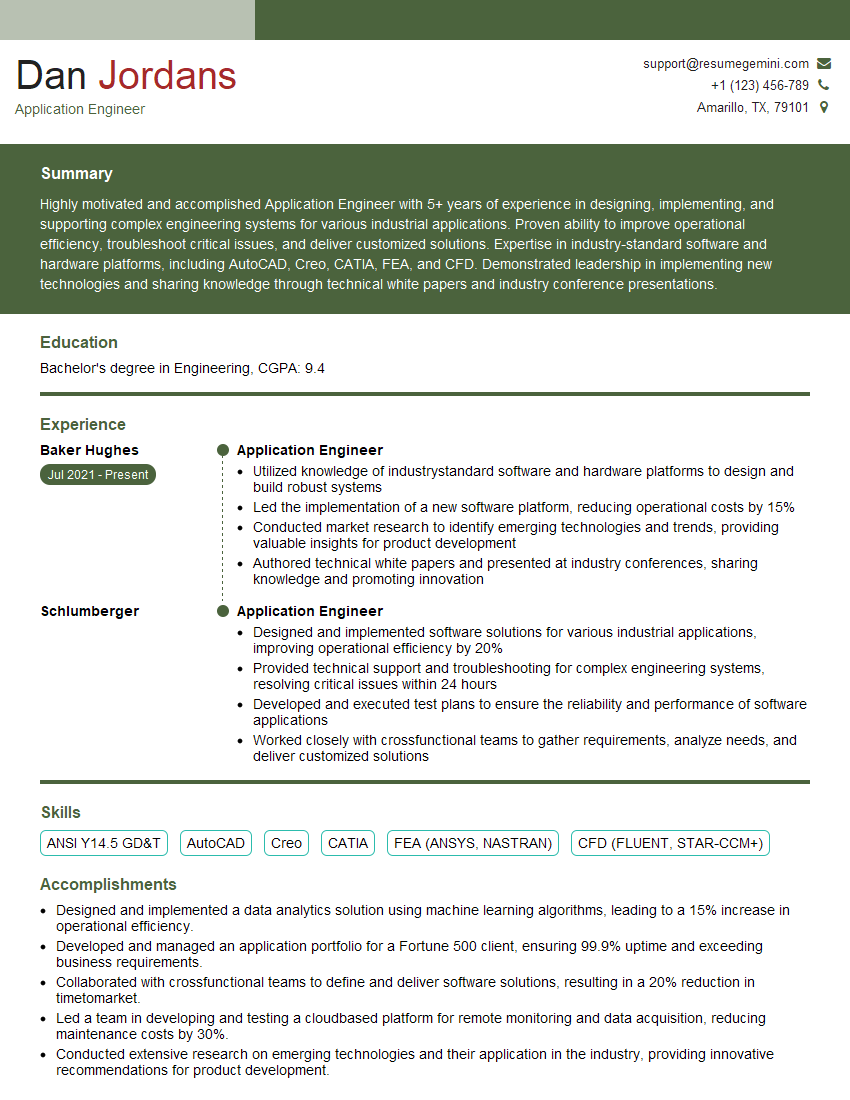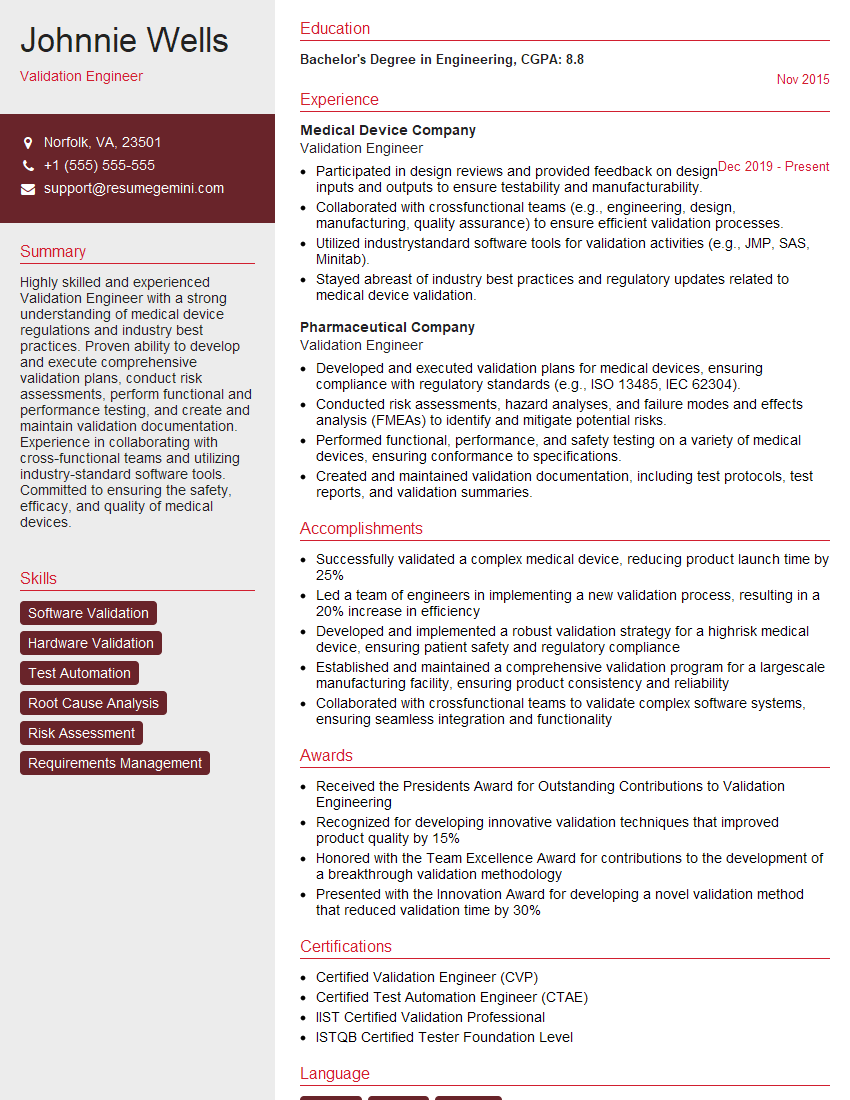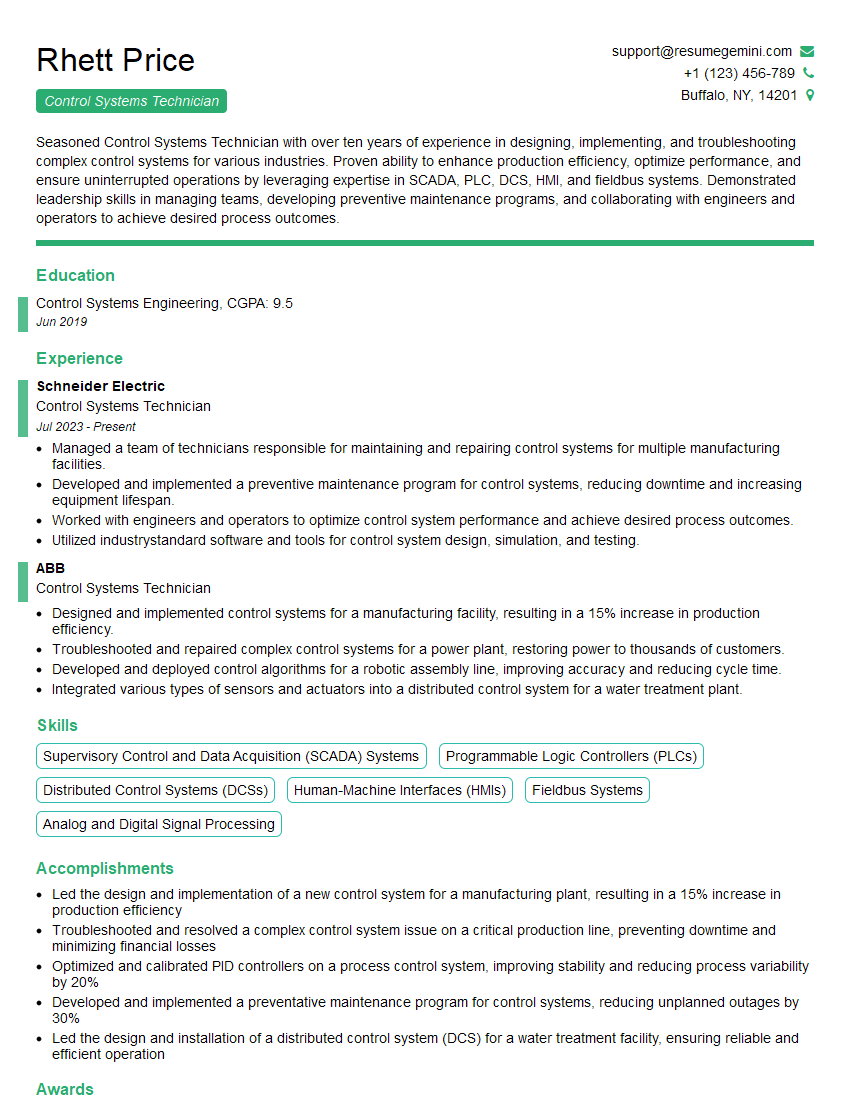Interviews are opportunities to demonstrate your expertise, and this guide is here to help you shine. Explore the essential Structured Text (ST) interview questions that employers frequently ask, paired with strategies for crafting responses that set you apart from the competition.
Questions Asked in Structured Text (ST) Interview
Q 1. Explain the data types supported in Structured Text.
Structured Text (ST) supports a variety of data types, mirroring those found in many other programming languages. Understanding these is crucial for writing efficient and reliable PLC programs. They can be broadly categorized as:
- Elementary Data Types: These are the fundamental building blocks. Examples include:
BOOL(Boolean): Represents true (TRUE) or false (FALSE).INT(Integer): Represents whole numbers (e.g., -32768 to 32767).UINT(Unsigned Integer): Represents non-negative whole numbers (e.g., 0 to 65535).REAL(Real Number): Represents floating-point numbers (e.g., 3.14159).LREAL(Long Real): Represents double-precision floating-point numbers, offering greater precision.STRING: Represents sequences of characters (text).DATE: Represents a calendar date.TIME: Represents a time of day.DATE_AND_TIME: Combines date and time information.- Derived Data Types: These are built upon the elementary types. Examples include:
ARRAY: A collection of elements of the same data type.STRUCT: A collection of elements of potentially different data types, organized as a record.ENUM: Defines a set of named constants.
Choosing the correct data type is essential for memory efficiency and program clarity. For instance, using an INT instead of a REAL when dealing with whole numbers saves memory and can lead to faster execution.
Q 2. Describe the difference between VAR, VAR_INPUT, and VAR_OUTPUT.
In Structured Text, VAR, VAR_INPUT, and VAR_OUTPUT define the scope and accessibility of variables within a program or function block. Think of them like containers for your data, with varying levels of access control.
VAR: Declares variables that are local to the program or function block. They can be read from and written to within that specific scope. Imagine these as private notes – only accessible within your current project.VAR_INPUT: Declares input variables. These variables receive data from outside the program or function block. They can be read but not written within the block. Think of these as parameters you provide when calling a function.VAR_OUTPUT: Declares output variables. These variables send data outside the program or function block. They can be written to within the block but cannot be written to from outside. These represent the results of your computations.
For example:
FUNCTION_BLOCK MyBlock
VAR_INPUT
x : INT;
END_VAR
VAR_OUTPUT
y : INT;
END_VAR
VAR
z : INT;
END_VAR
BEGIN
z := x + 5;
y := z * 2;
END_FUNCTION_BLOCK;In this example, x is an input, y is an output, and z is an internal variable only accessible within MyBlock.
Q 3. How do you handle arrays and structures in Structured Text?
Arrays and structures are powerful tools in ST for managing collections of data. They allow you to organize and process information efficiently.
- Arrays: An array is an ordered collection of elements of the same data type. You declare them by specifying the data type, the array name, and its size (number of elements). Elements are accessed using index numbers, starting from 0.
VAR
myArray : ARRAY[0..9] OF INT;
END_VAR
myArray[0] := 10;
myArray[5] := myArray[0] + 5;- Structures: A structure groups variables of different data types under a single name. This resembles a record in other languages, allowing you to treat related data as a single unit.
TYPE
MyStruct : STRUCT
name : STRING;
value : REAL;
END_STRUCT;
END_TYPE
VAR
myStruct : MyStruct;
END_VAR
myStruct.name := 'Sensor1';
myStruct.value := 25.5;Arrays and structures are often used together. For example, you might have an array of structures, representing multiple sensor readings, each with a name and value.
Q 4. What are the different loop structures available in Structured Text and when would you use each?
Structured Text offers several loop structures to control the execution flow. The best choice depends on the specific task.
FORloop: Ideal for iterating a known number of times. Think of it like repeating a task a specific number of times.
FOR i := 0 TO 9 DO
myArray[i] := i * 2;
END_FOR;WHILEloop: Repeats a block of code as long as a condition is true. Useful for situations where the number of iterations isn’t known in advance, but depends on some condition. This is similar to saying, ‘Keep doing this until something changes’.
WHILE condition DO
// Code to execute
END_WHILE;REPEAT...UNTILloop: Executes a block of code at least once, and then repeats as long as a condition is false. It is guaranteed to run at least one time. This is useful when you need to perform an action at least once, even if the condition might not be initially met.
REPEAT
// Code to execute
UNTIL condition;Choosing the right loop is critical for program efficiency and readability. A FOR loop is more efficient for iterating through arrays, while WHILE and REPEAT...UNTIL are better for conditions that are not predetermined.
Q 5. Explain the use of CASE statements in Structured Text.
The CASE statement in Structured Text provides a structured way to select one block of code to execute from several possible options based on the value of an expression. It’s like a sophisticated ‘if-then-else’ for multiple choices.
CASE sensorValue OF
1: output := 'Low';
2: output := 'Medium';
3: output := 'High';
ELSE
output := 'Unknown';
END_CASE;In this example, the CASE statement evaluates sensorValue. If it equals 1, the output is set to ‘Low’, if it equals 2, to ‘Medium’, and so on. The ELSE clause handles any values not explicitly listed.
CASE statements are highly efficient for selecting actions based on a discrete set of values. They improve code readability and maintainability, especially when dealing with many conditional branches.
Q 6. How do you implement functions and function blocks in Structured Text?
Functions and function blocks are fundamental for modularity and reusability in ST. They allow you to encapsulate code into reusable units.
- Functions: Functions are similar to mathematical functions; they take input parameters, perform calculations, and return a single value. They are typically used for self-contained computations that don’t need to maintain internal state.
FUNCTION MyFunction : REAL
VAR_INPUT
a : REAL;
b : REAL;
END_VAR
BEGIN
MyFunction := a + b;
END_FUNCTION;- Function Blocks: Function blocks are more complex than functions. They can have input and output variables, and they can maintain internal state between calls. Think of these as mini-programs with memory.
FUNCTION_BLOCK MyFunctionBlock
VAR_INPUT
x : INT;
END_VAR
VAR_OUTPUT
y : INT;
END_VAR
VAR
counter : INT := 0;
END_VAR
BEGIN
counter := counter + 1;
y := x * counter;
END_FUNCTION_BLOCK;Function blocks are suited for tasks requiring memory and state retention. Functions are best for simple, self-contained calculations. Proper use of both greatly enhances code organization and reusability.
Q 7. Describe the purpose of ‘IF’ and ‘THEN’ statements, and how to use them effectively.
IF and THEN statements form the basis of conditional logic in ST. They allow you to execute code only when a specific condition is met.
The basic structure is:
IF condition THEN
// Code to execute if condition is TRUE
END_IF;You can add an ELSE clause to handle the case when the condition is false:
IF condition THEN
// Code to execute if condition is TRUE
ELSE
// Code to execute if condition is FALSE
END_IF;For more complex logic, you can use ELSIF (else if) to add multiple conditions:
IF condition1 THEN
// Code for condition1
ELSIF condition2 THEN
// Code for condition2
ELSE
// Code for none of the above
END_IF;Example: A simple temperature controller
IF temperature > 100 THEN
turnOnFan := TRUE;
ELSE
turnOnFan := FALSE;
END_IF;Effective use of IF and THEN statements involves clear, concise conditions, and well-structured code blocks for improved readability and maintainability.
Q 8. What are the different ways to handle errors and exceptions in Structured Text?
Structured Text (ST) offers several ways to handle errors and exceptions, primarily through IF-THEN-ELSE structures and potentially TRY-EXCEPT blocks depending on the specific PLC implementation. Think of it like a road with potential detours. If something goes wrong (an exception occurs), you have a plan B.
The IF-THEN-ELSE structure allows you to check for specific error conditions (e.g., a sensor reading being out of range, a communication failure) and take appropriate actions. You can log the error, set a flag indicating a problem, initiate a recovery procedure, or simply halt execution.
IF sensor_reading > 100 THEN
error_flag := TRUE;
log_error("Sensor reading too high!");
ELSE
process_reading(sensor_reading);
END_IF;Some advanced PLC systems support TRY-EXCEPT blocks, similar to those in languages like Python. These offer a more structured way to handle exceptions. A TRY block contains the code that might throw an exception, while an EXCEPT block specifies the actions to take if an exception occurs. This keeps error handling localized and improves code readability.
Q 9. Explain the use of timers and counters in Structured Text.
Timers and counters are essential building blocks in ST for managing time-related events and counting occurrences. Imagine them as stopwatches and tally counters in your automation system.
Timers measure elapsed time. They are typically used to trigger actions after a specified delay. ST usually provides different timer types (e.g., TON – Timer On Delay, TOF – Timer Off Delay, RTO – Retentive Timer). A TON timer starts when its input is TRUE and times until a preset time is reached; its output then becomes TRUE.
TON timer1 : TON;
timer1(IN:= button_pressed, PT:=T#10s);
IF timer1.Q THEN
start_machine();
END_IF;Counters keep track of how many times an event happens. They increment their value when a specified input becomes TRUE. Counters are often used to control sequences, limit actions, or measure production counts.
CTU counter1 : CTU;
counter1(CU:= sensor_triggered, R:= reset_button);
IF counter1.CV >= 10 THEN
stop_process();
END_IF;Q 10. How do you create and use user-defined data types?
User-defined data types add structure and organization to your ST code. Instead of using basic data types like INT or BOOL, you can create custom types representing specific aspects of your system. Imagine building with LEGOs—custom types are like creating your own special bricks.
You define a new data type using the TYPE keyword, specifying the member variables and their data types. You then use this new type to declare variables.
TYPE MotorData :
speed : INT;
position : REAL;
status : BOOL;
END_TYPE;
VAR
motor1 : MotorData;
END_VAR;This creates a MotorData type with fields for speed, position, and status. Now, instead of managing individual variables for each motor property, you can access them using dot notation (e.g., motor1.speed).
Q 11. Describe the difference between a FOR loop and a WHILE loop.
Both FOR and WHILE loops are used for iteration in ST, but they differ in how they control repetition. Think of them as two different ways to walk down a path.
A FOR loop iterates a specific number of times. You define a counter variable that is initialized, incremented (or decremented), and checked against a limit. It’s perfect when you know how many iterations you need.
FOR i := 1 TO 10 DO
process_data(i);
END_FOR;A WHILE loop repeats as long as a condition is TRUE. The loop continues until the condition becomes FALSE. It’s ideal when you don’t know beforehand how many iterations are needed. Be cautious; an improperly designed WHILE loop could result in an infinite loop.
WHILE sensor_active DO
read_sensor();
END_WHILE;Q 12. Explain how to use bitwise operations in Structured Text.
Bitwise operations manipulate individual bits within integer variables. They’re useful for setting, clearing, or testing specific flags or bits within a data word—a highly efficient way to handle multiple on/off signals within a single variable. Imagine controlling numerous lights using a single multi-switch.
Common bitwise operators in ST include:
AND: Performs a logical AND operation on each bit. Both bits must be 1 for the result to be 1.OR: Performs a logical OR operation on each bit. If either bit is 1, the result is 1.XOR(Exclusive OR): If only one bit is 1, the result is 1; otherwise, it’s 0.NOT: Inverts each bit (0 becomes 1, and 1 becomes 0).SHL(Shift Left): Shifts bits to the left, filling in with zeros.SHR(Shift Right): Shifts bits to the right, filling in with zeros (or ones, depending on the implementation).
Example:
VAR
status : INT := 10; // Binary: 1010
result : INT;
END_VAR;
result := status AND 6; // Binary: 0110 Result will be 2 (Binary: 0010)Q 13. How do you handle string manipulation in Structured Text?
ST provides various functions for string manipulation, allowing you to work with textual data. Imagine this as your text editor built into the PLC.
Common string functions include:
CONCAT: Joins two or more strings together.LEFT,RIGHT,MID: Extract substrings.LEN: Returns the length of a string.FIND: Locates a substring within a string.REPLACE: Replaces occurrences of a substring.INSERT: Inserts a string into another string.
Example using CONCAT:
VAR
firstName : STRING := "John";
lastName : STRING := "Doe";
fullName : STRING;
END_VAR;
fullName := CONCAT(firstName, " ", lastName); // fullName will be "John Doe"Q 14. Describe different methods for debugging Structured Text code.
Debugging ST code involves systematically identifying and fixing errors. Your PLC system likely offers several debugging tools to aid this process.
Common debugging methods include:
- Online Monitoring: Watch variables’ values change in real-time using the PLC’s monitoring tools. It’s like watching the internal workings of the machine.
- Breakpoints: Pause execution at specific points in your code to examine variables and trace program flow. This is like pausing a video to understand each scene.
- Stepping through code: Execute the code one line at a time to closely analyze each step’s impact. It’s like reviewing each step of a detailed instruction.
- Logging: Write debugging messages (log files) that track variable values or program execution status. It is like having a logbook of the system’s actions.
- Simulation: Test your code in a simulated environment before deploying it to the actual PLC. It’s like practicing a complex operation in a safe test environment.
The specific debugging tools available will vary depending on the PLC system and programming environment used. Always refer to the PLC vendor’s documentation for detailed information on available debugging capabilities.
Q 15. Explain the concept of program organization and modularity in Structured Text.
Program organization and modularity in Structured Text (ST) are crucial for creating maintainable and reusable code. Think of it like building with LEGOs – instead of one giant, messy pile, you construct smaller, functional modules that can be easily combined and rearranged.
Modularity involves breaking down a large program into smaller, independent functions or function blocks (FBs). Each module performs a specific task, making the code easier to understand, debug, and modify. For instance, a module might control a conveyor belt, another might manage a sensor, and a third might handle data logging. This prevents a single change from causing cascading problems across the entire program.
Organization refers to the logical structuring of these modules. This often involves using well-defined naming conventions (e.g., using prefixes to indicate function type or module purpose), comments to explain code purpose and functionality, and a clear structure within the main program, perhaps using IF-THEN-ELSE statements or CASE statements to control the flow of execution.
Example: Instead of writing one monolithic function to control a complete robotic arm, you’d create separate functions for controlling each joint (e.g., MoveArmJoint1(angle), MoveArmJoint2(angle)). These functions can then be called sequentially from the main program to achieve complex arm movements. This approach drastically simplifies debugging; if joint 2 malfunctions, you only need to investigate the MoveArmJoint2 function.
Career Expert Tips:
- Ace those interviews! Prepare effectively by reviewing the Top 50 Most Common Interview Questions on ResumeGemini.
- Navigate your job search with confidence! Explore a wide range of Career Tips on ResumeGemini. Learn about common challenges and recommendations to overcome them.
- Craft the perfect resume! Master the Art of Resume Writing with ResumeGemini’s guide. Showcase your unique qualifications and achievements effectively.
- Don’t miss out on holiday savings! Build your dream resume with ResumeGemini’s ATS optimized templates.
Q 16. How do you implement state machines in Structured Text?
State machines are a powerful way to model systems with discrete states and transitions in ST. Imagine a traffic light – it has distinct states (red, yellow, green) and transitions between those states based on timing or external events.
In ST, you typically implement state machines using a CASE statement or a series of IF statements. A variable (often called currentState) tracks the current state of the system. Based on this state and any input conditions, the CASE statement or IF statements determine the next state and associated actions.
Example: A simple traffic light state machine:
TYPE TrafficLightState : (Red, Yellow, Green);
VAR
currentState : TrafficLightState := Red;
timer : TON;
END_VAR
CASE currentState OF
Red:
timer(IN:= TRUE, PT:= T#5s);
IF timer.Q THEN
currentState := Yellow;
END_IF;
Yellow:
timer(IN:= TRUE, PT:= T#2s);
IF timer.Q THEN
currentState := Green;
END_IF;
Green:
timer(IN:= TRUE, PT:= T#6s);
IF timer.Q THEN
currentState := Red;
END_IF;
END_CASE;This code uses a TON (timer on delay) function to manage time-based transitions. Each state has its own actions, and the transitions are clearly defined based on time and the timer.Q output (timer done).
Q 17. Describe your experience with different PLC platforms and their Structured Text implementations.
I have extensive experience with several PLC platforms and their ST implementations, including Siemens TIA Portal (using STEP 7), Rockwell Automation Studio 5000, and Schneider Electric PL7. Each platform offers similar ST functionality, following the IEC 61131-3 standard, but there are subtle differences in syntax and library functions.
For example, Siemens TIA Portal provides robust libraries for motion control and networking, while Rockwell Automation Studio 5000 excels in its integration with other enterprise systems. Schneider Electric PL7 often integrates seamlessly with their own hardware and software ecosystem.
My experience includes developing complex automation systems across these platforms, encompassing everything from simple data acquisition and control to sophisticated motion control and supervisory systems. I’m proficient in leveraging platform-specific features to optimize performance and reduce development time, while maintaining code portability where possible through adherence to the IEC 61131-3 standard.
Q 18. How do you handle data communication between different PLCs or devices using Structured Text?
Data communication between PLCs or devices using ST often relies on industrial communication protocols such as Profibus, Profinet, EtherNet/IP, Modbus TCP, and others. The specific implementation depends on the hardware and network infrastructure.
In ST, you’d typically use function blocks provided by the PLC vendor to handle the low-level communication details. These function blocks abstract the complexities of the protocol, allowing you to focus on the data exchange. For example, you might use a function block to read data from a remote PLC’s memory or write data to a remote device’s registers.
Example (Conceptual):
// Assuming a Modbus TCP function block called 'ModbusRead'
VAR
modbusClient : ModbusRead;
remoteIP : STRING := '192.168.1.100';
registerAddress : INT := 4000;
dataValue : INT;
END_VAR
modbusClient(ipaddress := remoteIP, address:= registerAddress);
dataValue := modbusClient.data;This simplified example shows how a Modbus TCP function block might be used to read an integer value from a remote device. The details of the Modbus communication are handled internally by the function block.
Error handling and robust communication strategies are essential. This includes implementing mechanisms to detect and handle communication failures, retries, and timeouts to ensure reliable data exchange.
Q 19. Explain your experience with version control systems for Structured Text code.
Version control is paramount for collaborative development and managing changes to ST code. I have extensive experience using Git, a widely adopted distributed version control system. It allows multiple developers to work simultaneously on the same codebase, tracking changes, resolving conflicts, and easily reverting to previous versions if needed.
My workflow typically involves creating branches for new features or bug fixes, committing code regularly with descriptive messages, and merging changes back into the main branch after thorough testing. Using Git also allows for creating and managing different versions of the code, enabling easier tracking during development and facilitating maintenance.
Furthermore, I’m familiar with using Git platforms like GitHub or GitLab, which offer additional benefits such as collaboration features, code review tools, and issue tracking. This helps to enhance the team’s productivity and maintain code quality.
Q 20. How do you ensure the reliability and maintainability of your Structured Text programs?
Reliability and maintainability are achieved through a combination of best practices and tools. Think of it like building a sturdy house – you need a solid foundation and well-organized structure. For ST code, this means:
- Well-structured code: Using modular design, clear naming conventions, and meaningful comments.
- Robust error handling: Implementing error checks, exception handling, and safe defaults to prevent unexpected behavior.
- Code reviews: Peer review helps catch errors early and ensures consistency in coding style.
- Testing: Implementing thorough unit tests and integration tests to validate code functionality.
- Documentation: Creating clear and concise documentation outlining the program’s purpose, functionality, and usage.
- Version control (Git): Tracking changes, enabling easy rollback, and facilitating collaboration.
By adhering to these principles, I ensure that the ST programs are not only functional but also easy to understand, maintain, and extend in the future. This also drastically reduces the risk of errors and downtime in the real-world application of the program.
Q 21. Describe your approach to troubleshooting and resolving issues in Structured Text code.
Troubleshooting ST code involves a systematic approach. It’s like detective work – you need to gather clues and follow the evidence.
My approach usually involves:
- Reproduce the error: Identify the precise conditions that lead to the issue.
- Examine the error messages: PLC error messages often provide valuable clues.
- Use debugging tools: Most PLC programming environments have debugging tools (breakpoints, watch variables) that allow you to step through the code and monitor variable values.
- Check the hardware: Rule out any physical issues that might be causing the problem.
- Analyze the program flow: Use the debugging tools to trace the execution path and identify where things go wrong.
- Simplify the code (if necessary): Temporarily remove or comment out sections of code to isolate the problem.
- Consult documentation and online resources: Search for solutions to similar problems.
For example, if I encounter a logic error, I use the debugger to trace the values of relevant variables and check whether they are consistent with the expected program behavior. If a communication error occurs, I’ll examine the communication settings and network configuration to ensure everything is properly set up. Through a methodical approach, I can efficiently identify and fix the root cause of the issue.
Q 22. Explain your experience with using Structured Text in industrial automation applications.
My experience with Structured Text (ST) in industrial automation spans over eight years, encompassing projects ranging from simple machine control to complex process automation systems. I’ve extensively used ST in Programmable Logic Controllers (PLCs) from various manufacturers like Siemens, Rockwell Automation, and Schneider Electric. For instance, in one project involving a high-speed packaging line, I utilized ST to develop the control logic for precise timing and synchronization of multiple conveyor belts and robotic arms. This required intricate handling of Boolean logic, timers, counters, and complex data structures within the ST program to ensure seamless operation and minimal downtime. Another significant project involved implementing a sophisticated supervisory control and data acquisition (SCADA) system using ST to interface with various field devices, manage data acquisition, and display real-time process information on a central monitoring system.
In another project focused on optimizing a chemical blending process, I employed ST to create advanced control algorithms, including PID controllers and fuzzy logic systems, dramatically improving process efficiency and reducing waste. The ability of ST to express complex logic in a clear and readable manner, coupled with its compatibility with various PLC platforms, made it the ideal choice for these demanding applications.
Q 23. How do you ensure data integrity and security in your Structured Text programs?
Data integrity and security are paramount in industrial automation. In my ST programs, I employ several strategies to ensure these critical aspects are addressed. First, I utilize strong data type definitions to prevent unexpected type mismatches and runtime errors. This reduces the risk of corrupted data. For example, explicitly defining variables as INT, REAL, BOOL etc. prevents accidental assignments of incompatible data types. Secondly, I implement robust error handling mechanisms. This involves checking for boundary conditions, using IF statements to validate data ranges before processing, and implementing exception handling blocks to gracefully manage unexpected events. Furthermore, I regularly review and test my code, employing both unit testing and integration testing to verify the accuracy and reliability of my ST programs.
Regarding security, I adhere to strict coding practices to prevent vulnerabilities. This includes using secure communication protocols (like Modbus TCP with appropriate security features) and limiting direct access to critical system components. In larger systems, I incorporate access control mechanisms that restrict program modification to authorized personnel only. Regular code reviews and security audits are also crucial to maintaining the integrity and security of the system.
Example: IF (sensorValue > maxValue) THEN errorFlag := TRUE; END_IF;Q 24. Describe your experience with optimizing Structured Text code for performance.
Optimizing Structured Text code for performance is crucial, particularly in high-speed applications. My approach involves several key techniques. First, I carefully consider the data structures I utilize. For instance, choosing arrays over repeated variables when dealing with a large number of similar data points. Using more efficient data types (e.g., using INT instead of DINT when the range permits) also improves performance. Secondly, I avoid unnecessary calculations or function calls within loops. Moving calculations outside loops if possible significantly reduces processing time. I also optimize algorithm complexity where appropriate, selecting algorithms with lower computational complexity. For example, I would carefully consider using efficient search algorithms rather than brute force methods when searching through large data sets.
Thirdly, I leverage the PLC’s built-in functions whenever possible as they are usually highly optimized for the target hardware. Finally, I use profiling tools to identify bottlenecks in my ST code and prioritize optimization efforts. Understanding the hardware and software environment is essential to effective code optimization.
Example: Instead of: FOR i:=1 TO 1000 DO complexCalculation(i); END_FOR; //InefficientConsider: preCalculatedArray[i]:=complexCalculation(i); //Pre-calculate and store valuesQ 25. Explain your understanding of IEC 61131-3 standard and its relevance to Structured Text.
The IEC 61131-3 standard is foundational to industrial automation programming. It defines five programming languages for PLCs, including Structured Text. Its relevance lies in ensuring interoperability and portability across different PLC platforms. By adhering to the IEC 61131-3 standard, you can write ST code that can, in theory, be deployed on PLCs from different vendors with minimal modifications, reducing development time and cost. The standard also specifies data types, functions, and other programming constructs, ensuring consistency and improving code readability and maintainability. Furthermore, the standardization promotes best practices and helps to avoid platform-specific pitfalls and idiosyncrasies, leading to more robust and reliable automation systems. This universality promotes collaboration between engineers using different PLC brands and contributes to a more standardized and efficient automation industry.
Q 26. How would you implement a PID controller using Structured Text?
Implementing a PID controller in Structured Text involves defining the controller parameters (Kp, Ki, Kd) and the control loop. Here’s a simplified example:
VAR setpoint : REAL; processValue : REAL; error : REAL; integral : REAL; derivative : REAL; output : REAL; Kp : REAL := 1.0; Ki : REAL := 0.1; Kd : REAL := 0.01;END_VAR//PID Calculationerror := setpoint - processValue;integral := integral + error * CYCLE_TIME;derivative := (error - previousError) / CYCLE_TIME;output := Kp * error + Ki * integral + Kd * derivative;previousError := error;//Output saturation and other logic can be added here.This code snippet demonstrates a basic implementation. A real-world PID controller would likely include features like anti-windup, output limiting, and possibly more sophisticated tuning algorithms. The CYCLE_TIME variable represents the PLC’s scan cycle time. The values of Kp, Ki, and Kd need to be tuned based on the specific process being controlled.
Q 27. Describe your experience with different communication protocols (e.g., Modbus, Profibus) in the context of Structured Text.
My experience encompasses various communication protocols within the context of Structured Text. I’ve worked with Modbus TCP and RTU extensively for communication with various field devices like sensors, actuators, and remote I/O modules. In ST, these protocols are typically accessed through function blocks or libraries provided by the PLC manufacturer. For example, a Modbus TCP function block would take parameters such as the slave address, function code, and data registers as input and return the requested data or write data to the specified registers. I have also used Profibus for high-speed and deterministic communication in complex systems, often involving intricate configuration using dedicated function blocks and libraries within the PLC programming environment.
For instance, in a project involving a distributed control system (DCS), I used ST in conjunction with Modbus TCP to collect data from multiple remote PLCs and aggregate it in a central supervisory system. The communication was implemented using Modbus function blocks within the ST code, allowing for efficient data exchange and synchronization across the network. The careful handling of communication errors, timeouts, and data integrity checks was crucial for the system’s reliable performance.
Beyond Modbus and Profibus, I possess experience with other protocols such as Ethernet/IP and Profinet, adapting my ST code to interface with various field devices and networks based on project requirements. Choosing the right protocol is crucial for the project’s success, dependent upon factors such as speed, bandwidth, network topology and the devices involved. The ability to effectively integrate and manage different communication protocols in ST is vital for developing robust and flexible industrial automation solutions.
Key Topics to Learn for Structured Text (ST) Interview
- Understanding ST Fundamentals: Grasp the core principles of Structured Text, including its syntax, data types, and operators. Familiarize yourself with the differences between ST and other markup languages.
- Data Structures in ST: Explore how to effectively manage and manipulate data using arrays, records, and other relevant ST data structures. Practice implementing these in various scenarios.
- ST Program Flow Control: Master control structures like IF-THEN-ELSE statements, FOR and WHILE loops, and CASE statements. Understand how to design efficient and readable code using these constructs.
- Functions and Procedures in ST: Learn how to create reusable code blocks through functions and procedures. Practice designing modular and well-organized ST programs.
- Error Handling and Debugging: Develop skills in identifying, diagnosing, and resolving errors in ST code. Familiarize yourself with debugging techniques and best practices.
- Practical Application: Consider how ST is used in industrial automation, process control, or similar fields relevant to your target roles. Prepare examples showcasing your problem-solving skills within the ST context.
- Advanced ST Concepts (Optional): Depending on the seniority of the role, explore advanced topics like object-oriented programming concepts within ST, or specific ST libraries and extensions.
Next Steps
Mastering Structured Text (ST) significantly enhances your career prospects in automation, industrial control, and related fields. A strong understanding of ST demonstrates valuable technical skills highly sought after by employers. To maximize your chances of success, create an ATS-friendly resume that highlights your ST proficiency. ResumeGemini is a trusted resource to help you build a professional and impactful resume that grabs recruiters’ attention. We provide examples of resumes tailored to showcase Structured Text (ST) expertise, enabling you to present your skills effectively.
Explore more articles
Users Rating of Our Blogs
Share Your Experience
We value your feedback! Please rate our content and share your thoughts (optional).
What Readers Say About Our Blog
Hello,
We found issues with your domain’s email setup that may be sending your messages to spam or blocking them completely. InboxShield Mini shows you how to fix it in minutes — no tech skills required.
Scan your domain now for details: https://inboxshield-mini.com/
— Adam @ InboxShield Mini
Reply STOP to unsubscribe
Hi, are you owner of interviewgemini.com? What if I told you I could help you find extra time in your schedule, reconnect with leads you didn’t even realize you missed, and bring in more “I want to work with you” conversations, without increasing your ad spend or hiring a full-time employee?
All with a flexible, budget-friendly service that could easily pay for itself. Sounds good?
Would it be nice to jump on a quick 10-minute call so I can show you exactly how we make this work?
Best,
Hapei
Marketing Director
Hey, I know you’re the owner of interviewgemini.com. I’ll be quick.
Fundraising for your business is tough and time-consuming. We make it easier by guaranteeing two private investor meetings each month, for six months. No demos, no pitch events – just direct introductions to active investors matched to your startup.
If youR17;re raising, this could help you build real momentum. Want me to send more info?
Hi, I represent an SEO company that specialises in getting you AI citations and higher rankings on Google. I’d like to offer you a 100% free SEO audit for your website. Would you be interested?
Hi, I represent an SEO company that specialises in getting you AI citations and higher rankings on Google. I’d like to offer you a 100% free SEO audit for your website. Would you be interested?
good



